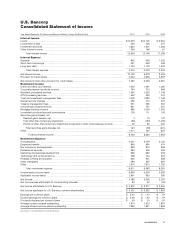US Bank 2011 Annual Report Download - page 83
Download and view the complete annual report
Please find page 83 of the 2011 US Bank annual report below. You can navigate through the pages in the report by either clicking on the pages listed below, or by using the keyword search tool below to find specific information within the annual report.
assets. Estimated useful lives range up to 40 years for newly
constructed buildings and from 3 to 20 years for furniture and
equipment.
Capitalized leases, less accumulated amortization, are
included in premises and equipment. Capitalized lease
obligations are included in long-term debt. Capitalized leases
are amortized on a straight-line basis over the lease term and
the amortization is included in depreciation expense.
Stock-Based Compensation The Company grants stock-
based awards, including restricted stock, restricted stock units
and options to purchase common stock of the Company.
Stock option grants are for a fixed number of shares to
employees and directors with an exercise price equal to the
fair value of the shares at the date of grant. Restricted stock
and restricted stock unit grants are awarded at no cost to the
recipient. Stock-based compensation for awards is recognized
in the Company’s results of operations on a straight-line basis
over the vesting period. The Company immediately recognizes
compensation cost of awards to employees that meet
retirement status, despite their continued active employment.
The amortization of stock-based compensation reflects
estimated forfeitures adjusted for actual forfeiture experience.
As compensation expense is recognized, a deferred tax asset is
recorded that represents an estimate of the future tax
deduction from exercise or release of restrictions. At the time
stock-based awards are exercised, cancelled, expire, or
restrictions are released, the Company may be required to
recognize an adjustment to tax expense, depending on the
market price of the Company’s common stock at that time.
Per Share Calculations Earnings per common share is
calculated by dividing net income applicable to U.S. Bancorp
common shareholders by the weighted average number of
common shares outstanding. Diluted earnings per common
share is calculated by adjusting income and outstanding shares,
assuming conversion of all potentially dilutive securities.
NOTE 2 Accounting Changes
Troubled Debt Restructurings On July 1, 2011, the
Company adopted accounting guidance issued by the
Financial Accounting Standards Board related to identifying
and disclosing TDRs, applicable to modifications occurring on
or after January 1, 2011. This guidance provides clarification
in determining whether a creditor has granted a concession
and whether a debtor is experiencing financial difficulties for
the purpose of determining whether a restructuring constitutes
a TDR. The adoption of this guidance resulted in additional
loan modifications considered to be TDRs which the
Company had not previously considered to be impaired, and
for which the allowance for credit losses had previously been
measured under a collective allowance for credit losses
methodology. These newly classified TDRs primarily relate to
whether or not (i) modifications to interest rates on individual
loans are below a market rate of interest, and (ii) a delay in
payment is insignificant. In addition, the Company now
includes covered loans and residential mortgage loans
repurchased from Government National Association
(“GNMA”) mortgage pools whose repayments are primarily
insured by the Federal Housing Administration or guaranteed
by the Department of Veterans Affairs in its presentation of
TDRs even though the exposure to loss on these loans is
significantly mitigated by the related loss share agreements or
guarantee. Further, the Company also includes loans in a trial
modification period as a result of this guidance. The adoption
of this guidance did not have a material impact on the
Company’s total allowance for credit losses.
NOTE 3 Business Combinations and
Divestitures
In January 2011, the Company acquired the banking
operations of First Community Bank of New Mexico (“FCB”)
from the FDIC. The FCB transaction did not include a loss
sharing agreement. The Company acquired 38 branch
locations and approximately $1.8 billion in assets, assumed
approximately $2.1 billion in liabilities, and received
approximately $412 million in cash from the FDIC. In
addition, the Company recognized a $46 million gain on this
transaction during the first quarter of 2011.
In 2010, the Company acquired the securitization trust
administration business of Bank of America, N.A. This
transaction included the acquisition of $1.1 trillion of assets
under administration and provided the Company with
approximately $8 billion of deposits at the time of closing.
During 2010, the Company exchanged its proprietary
long-term mutual fund business of U.S. Bancorp Asset
Management (formerly FAF Advisors, Inc.), an affiliate of the
Company, for cash consideration and a 9.5 percent equity
interest in Nuveen Investments. The Company recorded a
$103 million gain ($41 million after tax) related to this
transaction. The Company retained all other products and
services previously offered by U.S. Bancorp Asset
Management.
NOTE 4 Restrictions on Cash and Due from
Banks
The Federal Reserve Bank requires bank subsidiaries to
maintain minimum average reserve balances. The amount of
those required reserve balances were approximately $1.7
billion and $1.2 billion at December 31, 2011 and 2010,
respectively. At December 31, 2011 and 2010, the Company
held $8.5 billion and $10.1 billion, respectively of balances at
the Federal Reserve Bank. These balances are included in cash
and due from banks on the consolidated balance sheet.
U.S. BANCORP 81
























